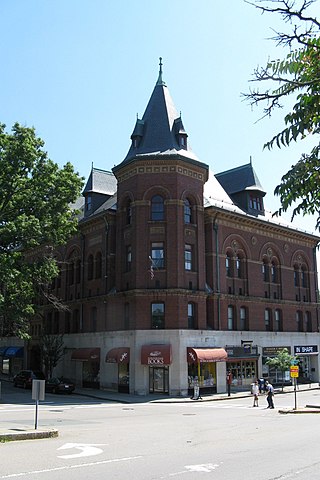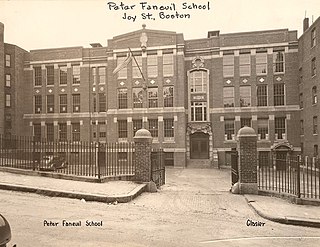
Suffolk County is located in the Commonwealth of Massachusetts, in the United States. As of the 2020 census, the population was 797,936, making it the fourth-most populous county in Massachusetts. The county comprises the cities of Boston, Chelsea, and Revere, and the town of Winthrop. The traditional county seat is Boston, the state capital and the largest city in Massachusetts. The county government was abolished in 1999, and so Suffolk County today functions only as an administrative subdivision of state government and a set of communities grouped together for some statistical purposes. Suffolk County is located at the core of the Boston-Cambridge-Newton, MA-NH Metropolitan Statistical Area as well as the greater Boston-Worcester-Providence, MA-RI-NH-CT Combined Statistical Area.

Newton is a city in Middlesex County, Massachusetts, United States. It is approximately 7 miles (11 km) west of downtown Boston, and comprises a patchwork of thirteen villages without a city center. It is home to the Charles River, Crystal Lake, and Heartbreak Hill, among other landmarks. It is served by several streets and highways, as well as the Green Line D branch run by the MBTA.

Harvard Yard, in Cambridge, Massachusetts, is the oldest part of the Harvard University campus, its historic center and modern crossroads. It contains most of the freshman dormitories, Harvard's most important libraries, Memorial Church, several classroom and departmental buildings, and the offices of senior University officials including the President of Harvard University.

Chestnut Hill is a wealthy New England village located six miles (10 km) west of downtown Boston, Massachusetts, United States. It is best known for being home to Boston College and a section of the Boston Marathon route. Like all Massachusetts villages, Chestnut Hill is not an incorporated municipal entity. It is located partially in Brookline in Norfolk County; partially in the city of Boston in Suffolk County, and partially in the city of Newton in Middlesex County. Chestnut Hill's borders are defined by the 02467 ZIP Code. The name refers to several small hills that overlook the 135-acre Chestnut Hill Reservoir rather than one particular hill.

Forest Hills Cemetery is a historic 275-acre (111.3 ha) rural cemetery, greenspace, arboretum, and sculpture garden in the Forest Hills section of Jamaica Plain, a neighborhood in Boston, Massachusetts. The cemetery was established in 1848 as a public municipal cemetery for Roxbury, Massachusetts, but was privatized when Roxbury was annexed to Boston in 1868.

Newtonville is one of the thirteen villages within the city of Newton in Middlesex County, Massachusetts, United States.

West Newton is one of the thirteen villages within the city of Newton in Middlesex County, Massachusetts, United States.

Long Wharf is a historic American pier in Boston, Massachusetts, built between 1710 and 1721. It once extended from State Street nearly a half-mile into Boston Harbor; today, the much-shortened wharf functions as a dock for passenger ferries and sightseeing boats.

The Leather District is a neighborhood of Boston near South Street, between the Financial District and Chinatown. The Leather District is a tightly defined area bounded by Kneeland Street to the south, Essex Street to the north, Atlantic Avenue to the east and Lincoln Street to the west. It is so named due to the dominance of the leather industry in the late 19th century.
Newton College of the Sacred Heart was a small women's liberal arts college in Newton Centre, Massachusetts. It opened in 1946 and merged with Boston College in June 1974.

The Peirce School is a historic school building at 88 Chestnut Street, corner of Austin Street, in West Newton, Massachusetts. The brick building was built in 1895 and operated by the Newton Public Schools as an elementary school from 1895 until June 1951. It originally served grades one through eight, but at the time of its closing, it was a kindergarten through sixth grade (K–6) school. It was listed on the National Register of Historic Places on December 6, 1979.

The Second Church in Newton, United Church of Christ, is located at 60 Highland Street in West Newton, a village of Newton, Massachusetts. This church is rooted in the Congregational denomination, welcomes all visitors, and does not require uniformity of belief. Its present church building, a Gothic Victorian structure designed by architects Allen & Collens and completed in 1916, was listed in the National Register of Historic Places in 1990.

The Chestnut Hill Reservoir Historic District is a historic district encompassing the Chestnut Hill Reservoir and the surrounding water works facilities which were historically used to provide fresh water to Boston, Massachusetts, and surrounding towns. The district is nearly coextensive with the Chestnut Hill Reservation, a state park managed by the Massachusetts Department of Conservation and Recreation (DCR); those elements of the water works that are still required as an emergency backup are managed by the Massachusetts Water Resources Authority (MWRA). The reservoir is located between Beacon Street and Commonwealth Avenue in Boston's Chestnut Hill district, just east of the Boston College Main Campus Historic District.
East Parish Burying Ground, also known as Centre Street Burying Ground or Centre Street Cemetery, is an historic cemetery located at Centre and Cotton streets in the village of Newton Corner in the city of Newton, Massachusetts. On December 23, 1983, it was listed on the National Register of Historic Places. It has been called the "most important, the most evocative and also the most fragile historic site in the city."

The Masonic Building, located at 296 to 304 Walnut Street and 456 to 460 Newtonville Avenue in the village of Newtonville, in Newton, Massachusetts in the United States, is a historic building built in 1896 as a Masonic Lodge hall. It is a massive four-story redbrick Renaissance-style building with a turret on the corner and a steep slate pyramid roof. The upper floors are still used for meetings of Masonic lodges and appendant orders, while the lower floors are used for retail and office purposes. The building was approved for listing on the National Register of Historic Places in 1986, but due to owner objection it was not listed. However, it was included as a contributing property to the Newtonville Historic District when that district was expanded in 1990.

The Church of the Open Word is a historic Swedenborgian church building located at 19 Highland Avenue in the village of Newtonville, in Newton, Massachusetts. The congregation was organized in 1860 and a wooden chapel was erected on the rear of this property. The stone Gothic Revival building was erected on the front of the property in 1893.

The Henry I. Harriman House is a historic French château style house at 825 Centre Street in Newton, Massachusetts. Built in 1916 for Henry I. Harriman, it is one of Newton's most elegant 20th-century suburban estate houses. It is now part of the campus of the Boston College Law School. It was known as Putnam House, in honor of benefactor Roger Lowell Putnam, when the campus was that of Newton College of the Sacred Heart. It was listed on the National Register of Historic Places in 1990.

Langone Park is a waterfront park in the North End of Boston, Massachusetts. Established in 1973, it is named for Massachusetts state senator Joseph A. Langone, Jr. and his wife Clementina Langone. The park features a Little League Baseball field, a playground, and three bocce courts. It is located on Commercial Street at the edge of Boston Harbor, immediately to the west of the Andrew P. Puopolo Jr. Athletic Field.

Another Course to College (ACC) is a Public Pilot School located in Hyde Park, Boston, Massachusetts, United States.





















